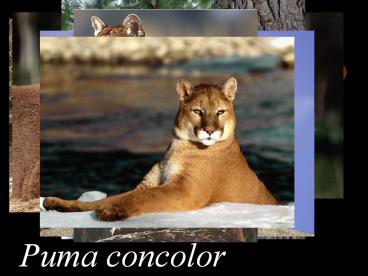Chapter 2 Classification PowerPoint PPT Presentation
1 / 22
Title: Chapter 2 Classification
1
Puma concolor
2
Chapter 2
- Classification
3
1
- Classification means organizing living things
into groups based on their similarities. - 2
- Scientists classify living and extinct organisms
to make them easier to study.
4
- 3
- Organisms are classified by shared
characteristics and their relationships between
one another. - 4
- The levels of classification go from very general
to very specific.
5
The 8 levels
- 5
- Domain Dumb
- Kingdom King
- Phylum Phylum
- Class Couldnt
- Order Order
- Family Fried
- Genus Green
- Species Spaghetti
6
- Classification for Humans
- Kingdom Animalia
- Phylum Chordata
- Class Mammalia
- Order Primates
- Family Hominidae
- Genus Homo
- species sapiens
7
- 6
- The science of classifying organisms is called
taxonomy. - 7 Taxonomy was founded by Linneaus in the 1700s.
- classified things only by their shared
characteristics. - developed the concept of binomial nomenclature
so scientists speaking and writing different
languages could communicate clearly.
8
- 8
- Modern taxonomists also look at evolutionary
relationships between animals.
9
A branching diagram can show the relationship
between organisms.
9
10
Organisms that are more closely related are
closer together on the branching diagram.
10
11
- 11
- When living things are classified, they get a
scientific name. - The scientific name is the same anywhere in the
world.
12
- 12
- Scientific names are usually Latin or Greek.
- The scientific name is always the Genus and
species name together. - 13
- The Genus is always written first and
capitalized. - The species is second and is always lowercase.
13
- 14
- The scientific name is always italicized or
underlined. - Ex Felis domesticus
- 15
- Scientists can use a dichotomous key to identify
unknown organisms.
14
DOMAINS
- Archaea Bacteria
Eukarya
15
KINGDOMS
- Archaebacteria
- Eubacteria
- Protista
- Fungi
- Plantae
- Animalia
16
- 17
- Bacteria are prokaryotic, meaning they do not
have nuclei. - All other living things are eukaryotic and have
true nuclei.
17
- 18
- Archaebacteria live in extreme environments (very
hot or cold) - They have been on the earth about 3 billion
years. - Most bacteria are in kingdom Eubacteria.
- Bacteria are either helpful or harmful living
everywhere on - earth.
18
(No Transcript)
19
Kingdom Protista
- 19
- Kingdom Protista consists of unicellular simple
multicellular organisms. - Protists are organisms that are not plants,
animals or fungi
20
Kingdom Plantae
- 20
- Plants are usually green and make food by
photosynthesis - They are complex, multicellular organisms
21
Kingdom Fungi
- 21
- They absorb food from their surroundings.
- Fungi are usually multicellular (except yeast).
22
Kingdom Animalia
- 22
- Most move around and have nervous systems.
- Animals are complex and multicellular.

